This section contains entries about our botanizing in Baja California written for the UC BEE (Oct 2012 to Aug 2021)
and The UC Hive (2022-), monthly newsletters for volunteers and staff of the UC Berkeley Botanical Garden.
Click on any photo for a larger image.
BEE MAY 2013
Spring Arrives — The Ditch Report — Racing Against the Clock — Cardons
Mulegé, BCS — Mar 16 to Apr 15, 2013
I love this time of the year here in Mulegé. There are plenty of the usual weather swings with the occasional crazy surprises (last month’s local weather refrain really should include April), but the temperatures are warming up nicely overall and the swings are not so painful. This is also the time for fog, as the hotter days warm up the Gulf’s surface layers and the evaporating water vapor forms dense fog banks offshore that can be seen to materialize literally out of thin air at any hour of the day.
Early morning or late afternoon, the fog may be pushed or pulled along the river and/or Bahía Concepción, and then it’s suddenly dark, cool and quiet. Our place is on a hill overlooking both the river and the Gulf, and recently I woke very early one morning to a dense wall of fog right outside the window. For a moment, completely disoriented and half asleep, I had not a clue where I was. “Wha? How’d I get back to Oakland?” April weather is both a portent of the oppressive heat that is to come in the summer, and a reminder of how grateful we should all be to have such relatively mild winters.
With the onset of the warmer weather, especially much more intense sunlight (tzzzz goes the skin!), many of the introduced and/or opportunistic winter annuals and perennials are winding down. As they shrink back and wither away, depositing their copious seeds for some future good season, they leave behind those heartier native plants that will continue on into the summer or maybe even through to the fall.
Leguminous shrubs like Vinorama and Huisache, and trees such as Mesquite (Prosopis articulata) and Palo Blanco that were all busy putting on copious foliage throughout the winter, are now flowering.

Huisache or Sweet Acacia (Acacia farnesiana)
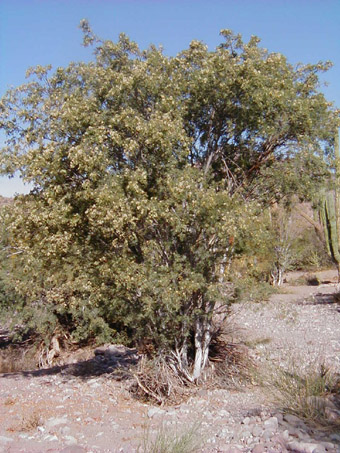 Palo Blanco (Lysiloma candidum, Fabaceae).
Palo Blanco (Lysiloma candidum, Fabaceae).
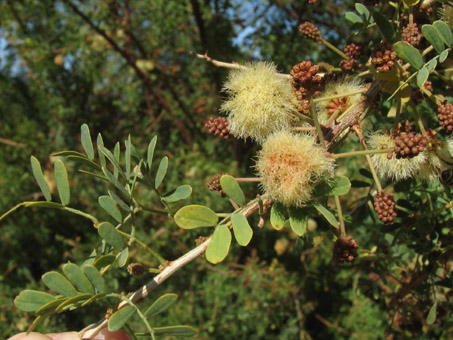
Palo Chino (Acacia peninsularis).
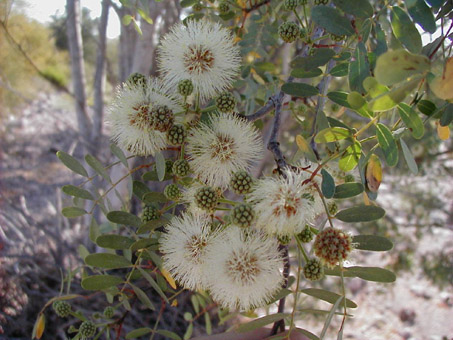
Flowers of Palo Blanco (Lysiloma candidum), named for its bold white bark, and with it's dark green foliage and reddish brown seedpods, is a picturesque tree of arroyos and hillsides in the southern half of Baja California Sur.
Thankfully, the majority of the Mango trees (Mangifera indica, Anacardiaceae) have finally stopped blooming and are now heavy with tiny young mangos, some of which will ripen around July. Over a period of about 6-8 weeks in February and March, the copious mango pollen, in conjunction with the copious date palm pollen, had terrorized many of us allergy-prone folks and kept us indoors, as well as sent a large number to the hospital for respiratory distress. I’ll no longer leave Oakland bound for Mulegé without my inhaler, as it really saved me from a similar fate again this year!
Ditch Report — update Mar 16 to Apr 15, 2013
Globemallows and Tobacco rule here in the ditch. Our three local species of Sphaeralceas (S. ambigua, S. coulteri and S. axillaris var. violaceae) have taken over and are reaching gargantuan scale. I just saw one plant that was well over 2.5 meters high with a branch span of about 1.5 meters! They are normally around 1-1.5 m tall. In the order above, the flowers are orange, golden and lavender (the latter is endemic to BCS). The bees and wasps love them, and they add wonderful splashes of color throughout the palm orchards.
Desert tobacco (Nicotiana obtusifolia), with its smaller, fuzzy leaves and Tree Tobacco (N. glauca) are doing very well all throughout the palm orchards. The third tobacco species, Nicotiana clevelandii has dropped out completely. Nama coulteri, while not quite as lush in some spots, is still putting on a fantastic show, covering a lot of ground in the ditch and throughout the shady orchards. During my visits to the ditch, there is a certain place where the fragrance of all of the Nama flowers builds and becomes quite heady as it wafts along on the warm breeze.

These are globemallows in mid March. They are now about a foot higher than I can reach on tippy toes.
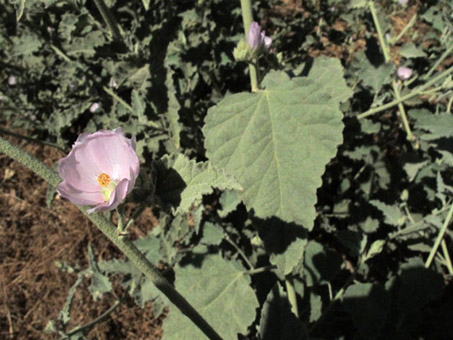
Sphaeralcea axillaris var. violacea, a local endemic.
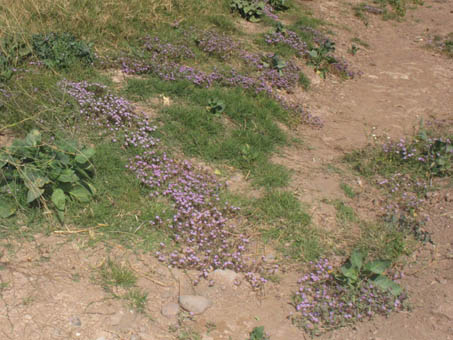
Purplemat (Nama coulteri), doing its thing in the ditch.
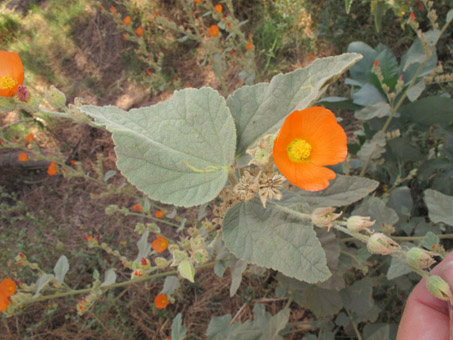
Sphaeralcea ambigua (Malvaceae), orange globemallow. This widespread species is found throughout the Sonoran Desert.
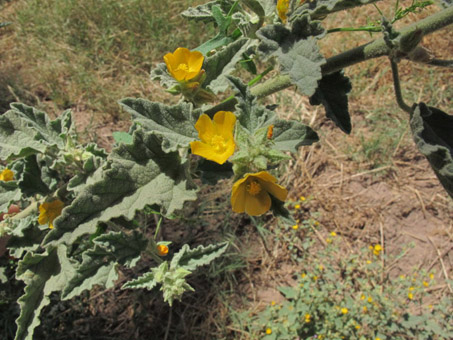
Sphaeralcea coulteri, a Sonoran Desert native.
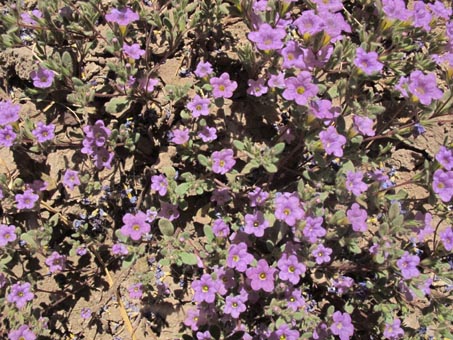
Nama coulteri flowers have an amazingly lovely fragrance.
Racing against the clock
As I’ve noted before, the weather has played a large part in how plants have been faring this season, with several freezes and extremely hot, dry days damaging or killing a number of herbs. The weather aside, I am still in a race to get photos and specimens of a couple of plants before the animals further churn them up or chomp them all to the ground. Some of the extremely well-fed culprits are seen in the photo at the top of the page and it is clear that they are totally unabashed and unrepentant about their crimes against nature. The horse I startled at the Ojo was even a little testy when I interrupted his lush repast of Bermuda grass, Schoenoplectus and Ricinis.
Ironically, the voracious herbivores have actually helped out a couple of times: they have weed-whacked all around a number of species that they must find unpalatable, exposing them to the eyes of wandering botanists who would otherwise have never seen them amidst the dense Bermuda grass. One of these herbs is so unpleasantly odiferous that I don’t think I have to worry about it being eaten anytime soon, unless the goats end up liking it.
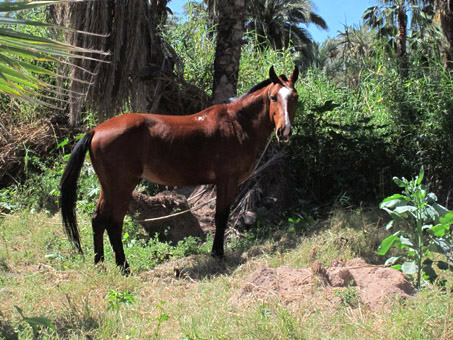
Well-fed horse at the Ojo. Usually the animals are very thin.
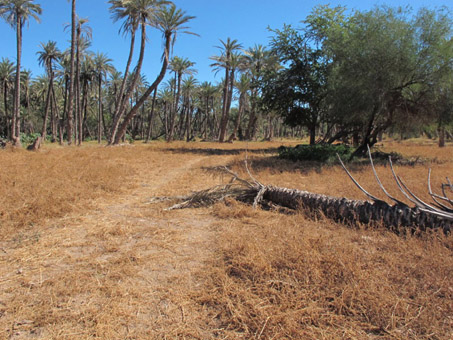
In February after cold and heat; but with little grazing.
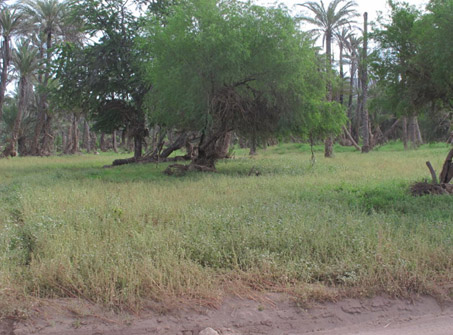
What one field in the orchard looked like in mid November.
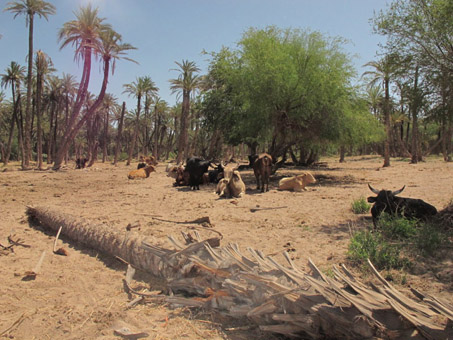
April, 2 weeks after the cows were put out to pasture: bare silt.
Desert scrub
The cold weather and freezes out in the valley seem to have delayed the blooming of a number of species, most noticeably the arborescent Cardón cactus, which didn’t start producing buds until the very end of March. It was interesting to note this, since the cacti out in front of our place and in many areas along the coast nearby were budding as early as the first week of February and had open flowers by late March. It isn’t uncommon for these gigantic cacti to sit out a year or more between blooming events. However, this year it seems that the heavy rains were very favorable to them and the ones near us are blooming even more spectacularly than they did last year.
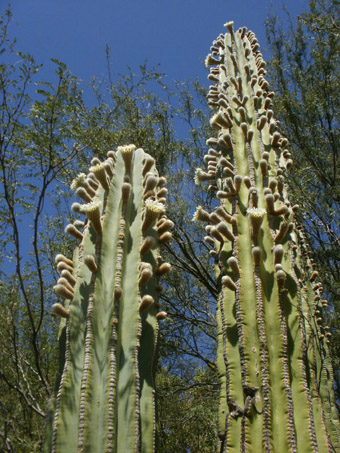
Cardón (Pachycereus pringlei, Cactaceae). Flowers usually grow in an arc of about 270° around the NE to NW side of the stems, in the upper portion.
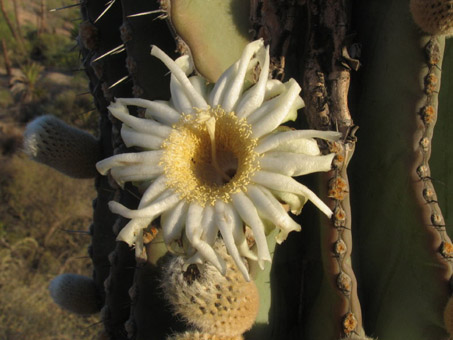
Closeup of the Cardón flower. Many of the buds seen at left are staminate (produce only pollen) and these will eventually drop off, leaving a much smaller number of pollinated flowers that will produce mature fruits in mid to late summer.
Mid April is also the time for the Palo Verde (Parkinsonia microphylla) to bloom. On a recent trip out to Bahía Concepción south of town, the hillsides and plains were ablaze with the bright yellow trees. Caught just right in the sunlight, the trees seem to glow through the otherwise brown and gray vegetation of their neighbors.
Stay tuned for next month's entry...
— Debra Valov, curatorial volunteer

















